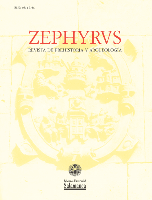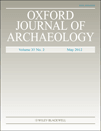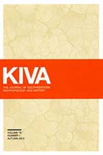
Zephyrus-Revista de Prehistoria y Arqueologia
Scope & Guideline
Championing Cutting-Edge Research in Archaeology
Introduction
Aims and Scopes
- Prehistoric and Archaeological Research:
The journal publishes studies that explore various aspects of prehistoric and archaeological findings, including artifacts, sites, and cultural practices across different periods. - Material Culture Analysis:
A significant focus on the analysis of material culture, including pottery, tools, and architectural remains, to understand the socio-economic dynamics of past societies. - Scientific and Technological Methods:
Incorporation of scientific methods such as archaeometry, geochemistry, and radiocarbon dating to enhance the understanding of archaeological materials and contexts. - Cultural Interactions and Exchanges:
Research on cultural interactions, trade, and exchanges between different civilizations, particularly in the Iberian Peninsula and surrounding regions. - Ritual and Symbolic Practices:
Exploration of ritual and symbolic practices in prehistoric and historical contexts, including funerary customs, religious sites, and artistic expressions.
Trending and Emerging
- Interdisciplinary Approaches:
There is a growing trend towards interdisciplinary studies that combine archaeology with other fields such as anthropology, history, and environmental science to provide holistic insights into past societies. - Technological Innovations in Archaeology:
The integration of new technologies, such as GIS, remote sensing, and 3D modeling, is increasingly prevalent in recent publications, enhancing the analysis of archaeological sites and artifacts. - Community and Identity Studies:
Research focusing on the social dynamics of ancient communities, including identity formation, social structures, and community interactions, is gaining traction. - Environmental Archaeology:
A significant increase in studies examining the relationship between ancient societies and their environments, including subsistence strategies and resource management, is evident. - Ritual and Symbolic Landscapes:
Emerging research on the significance of ritual practices and landscapes, exploring how they shape and reflect cultural identities, is becoming a key focus area.
Declining or Waning
- Traditional Archaeological Excavation Reports:
There has been a noticeable decrease in the publication of straightforward excavation reports, indicating a shift towards more interpretative studies that integrate a variety of methodologies. - Narrow Regional Studies:
Research focusing exclusively on narrow geographic regions without broader contextualization has become less common, as the journal encourages comparative studies across regions. - Descriptive Analyses of Artifacts:
The emphasis on purely descriptive analyses of artifacts without theoretical or contextual frameworks is declining, as the journal increasingly favors studies that provide deeper insights into cultural significance.
Similar Journals

Revista de Arqueologia Historica Argentina y Latinoamericana
Unlocking the Secrets of History, One Artifact at a TimeRevista de Arqueologia Historica Argentina y Latinoamericana is a vital scholarly journal dedicated to the field of archaeology, with a particular focus on the historical dimensions of Argentina and Latin America. Published by the Assoc Professional Archaeologists Argentine Republic, this open-access journal has been enriching the archaeological discourse since 2007, making its valuable content freely accessible to researchers, professionals, and students around the globe. With an ISSN of 1851-3190 and an E-ISSN of 2344-9918, the journal aims to foster a deeper understanding of the archaeological heritage of the region by publishing innovative research articles, critical reviews, and methodological advancements in the study of historical archaeology. Positioned as a prominent platform for scholarship, it plays a crucial role in advancing archaeological knowledge while promoting interdisciplinary approaches within the field.

Oxford Journal of Archaeology
Elevating Archaeological Scholarship to New HeightsOxford Journal of Archaeology is a prestigious peer-reviewed journal published by WILEY, dedicated to advancing the field of archaeology through innovative research and insightful discourse. Established in 1982, this journal has become a vital resource, showcasing high-impact studies that resonate within the arts and humanities, as well as interdisciplinary fields such as geography and planning. With an impressive Q1 ranking in both Archaeology and Arts & Humanities categories, and a Q2 ranking in Geography, Planning, and Development, the journal consistently maintains its reputation for excellence—evidenced by its ranking in the 81st percentile within the Scopus Arts and Humanities Archaeology category. The Oxford Journal of Archaeology not only provides scholars, professionals, and students with access to cutting-edge archaeological research but also encourages collaboration and dialogue among a diverse academic community. Although the journal does not currently offer Open Access, it remains a crucial platform for those seeking to expand their knowledge and impact in this dynamic field.

Stratum Plus
Navigating the Rich Tapestry of Human ExperienceStratum Plus, published by HIGH ANTHROPOLOGICAL SCH UNIV, is a distinguished academic journal based in Moldova that focuses on the fields of Anthropology, Archeology, and History. With an impressive impact factor reflecting its stature—ranked in the Q2 category for both Anthropology and Archeology, and Q1 for Archeology in the arts and humanities—this journal is a vital resource for scholars, professionals, and students alike. The journal's comprehensive scope encompasses a wide array of interdisciplinary studies, making it a beacon for innovative research and critical discourse within these disciplines. Since its inception in 2014, Stratum Plus has strived to foster academic excellence and knowledge dissemination, thus playing a crucial role in shaping contemporary anthropological and archaeological thought. While currently not available as Open Access, the journal maintains a strong online presence, with access options available through institutional subscriptions. Located at ZIMBRULUI 10A ST, KISHINEV MD-2024, MOLDOVA, Stratum Plus invites contributors and readers to engage with cutting-edge research that continues to enrich the global academic community.

Vjesnik Arheoloskog Muzeja u Zagrebu
Bridging Cultures Through Archaeological DiscoveryVjesnik Arheoloskog Muzeja u Zagrebu, published by the ARHEOLOSKI MUZEJ & ZAGREBU, is a vital platform for disseminating scholarly research in the field of archaeology. With its Open Access model established in 2007, the journal ensures that vital archaeological findings and theories are accessible to a global audience, fostering greater collaboration and knowledge-sharing among researchers, professionals, and students. The journal is based in Croatia and has been an essential part of the academic landscape since its inception, with convergence noted in years such as 1979 and 1981, and continuing consistently from 2014 to 2023. While it currently holds a Q4 ranking in both the Arts and Humanities and Archaeology categories, its contributions to the understanding of archaeological heritage in the region are invaluable. Positioned within the 30th percentile among its peers in Scopus rankings, the journal endeavors to elevate the discourse around archaeological practices and findings, making it an important resource for anyone engaged in the pursuit of archaeological knowledge.

Prilozi Instituta za Arheologiju u Zagrebu
Advancing archaeological discourse and heritage exploration.Prilozi Instituta za Arheologiju u Zagrebu is a prominent academic journal published by INST ARHEOLOGIJU, dedicated to advancing the field of archaeology and related historical studies. Operating in Croatia, this journal serves as a vital platform for scholars, researchers, and students to disseminate innovative research and insights within the realm of archaeology, with a focus on the rich cultural heritage of the region. The journal spans contributions from 2002 to 2011 and has ongoing publication since 2013, reflecting its commitment to contemporary archaeological discourse. With a growing reputation, it has achieved a Q3 ranking in the fields of Archaeology and Arts and Humanities, and a Q2 ranking in History, signifying its impact and relevance in the academic community. Although Open Access options are not available, the journal remains an essential resource for those pursuing in-depth knowledge and research in archaeology. Researchers can harness the journal's extensive scope to explore critical historical narratives and archaeological findings, solidifying its importance in both local and global contexts.

Lucentum
Empowering Scholars, Enriching MindsLucentum is a distinguished open-access journal published by Universidad de Alicante, focusing on the interdisciplinary fields of Archeology, History, and Paleontology. Since its inception in 1982, it has established itself as a vital platform for scholars and researchers to disseminate their findings, contributing significantly to the academic landscape in Spain and beyond. The journal's notable rankings, including Q1 status in History and Q2 in Archeology, reflect its commitment to high-quality scholarship and rigorous peer review. With an impressive impact factor and recognition in Scopus, Lucentum serves as an essential resource for professionals, students, and historians, fostering a deeper understanding of cultural and historical contexts through a wealth of interdisciplinary research. The journal continues to embrace open access, ensuring that critical knowledge is freely available to the global research community.

Praehistorische Zeitschrift
Exploring Humanity's Roots Through Rigorous ResearchPraehistorische Zeitschrift is a premier scholarly journal dedicated to the field of archaeology, published by WALTER DE GRUYTER GMBH in Germany. With a rich history dating back to 1909, the journal has evolved to encompass a wide range of topics pertaining to prehistory, offering vital insights into archaeological practices, theories, and discoveries. Recognized as a Q1 journal in both the Archaeology category of Arts and Humanities and the Social Sciences, it holds a prestigious position with Scopus rankings placing it in the top 20% of its field. Although it operates under a traditional publishing model without open access, its comprehensive articles are essential reading for researchers, professionals, and students alike who seek to deepen their understanding of prehistoric studies through rigorous academic contributions. The journal continues to publish significant research from 1993 to 2024 and beyond, making it an indispensable resource for anyone interested in the archaeological narrative of humanity.

Spal
Fostering Dialogue in the Study of Antiquity.Spal is a distinguished academic journal dedicated to the fields of Archaeology and History, published by the University of Seville, Editorial. With an ISSN of 1133-4525 and an E-ISSN of 2255-3924, it has established a prominent reputation within the scholarly community, currently enjoying an impressive Q1 ranking in Archeology (Arts and Humanities) and History, alongside a Q2 ranking in Archeology for 2023. The journal serves as a critical platform for researchers, professionals, and students alike, promoting the dissemination of cutting-edge research and innovative methodologies in these vital disciplines. Spal's Scopus Ranks place it in the 84th percentile for Arts and Humanities - History and the 72nd for Archeology within the field, emphasizing its impact and relevance in contemporary scholarship. Although it operates under a traditional access model, its commitment to advancing knowledge and discourse in archaeological and historical studies remains unwavering. The journal's coverage spans from 2015 to 2024, positioning it well to contribute to ongoing academic conversations and foster collaborations within the global research community.

Kiva-Journal of Southwestern Anthropology and History
Charting New Territories in Archaeological ResearchKiva - Journal of Southwestern Anthropology and History is a distinguished academic journal published by Routledge Journals, Taylor & Francis Ltd, that serves as a vital resource for scholars in the fields of anthropology, archaeology, and history. With an ISSN of 0023-1940 and an E-ISSN of 2051-6177, this journal has established itself as a significant avenue for scholarly communication since its inception in 1964. It consistently ranks in the top quartiles, including Q1 in Archaeology and Q2 in Anthropology, reflecting its high impact and rigorous peer-review process. Covering a wide array of topics pertinent to the Southwestern United States, Kiva invites original research articles, reviews, and methodological papers that advance understanding of the region's rich cultural heritage and historical narratives. While currently not open access, its commitment to disseminating quality research makes it an essential reading for researchers, professionals, and students aiming to explore the multifaceted dimensions of southwestern studies.

Archaeological and Anthropological Sciences
Exploring Humanity Through Science and HistoryArchaeological and Anthropological Sciences is an esteemed peer-reviewed journal published by Springer Heidelberg, specializing in the interdisciplinary fields of archaeology and anthropology. Since its inception in 2009, this journal has established itself as a pivotal resource for researchers and professionals, featuring cutting-edge studies that bridge the gap between the sciences and humanities. With its impressive 2023 Q1 rankings in Anthropology and Archaeology categories, the journal stands out in the Scopus landscape, ranking within the top 5% of its field—Rank #18/413 in Archaeology (Arts and Humanities) and Rank #28/502 in Anthropology. This is complemented by its commitment to disseminating high-quality research to a global audience, despite being a non-Open Access publication. The journal's scope encompasses innovative methodologies, archaeological findings, and anthropological insights that are vital for advancing knowledge and fostering academic discourse. As it moves toward its upcoming converged years, Archaeological and Anthropological Sciences continues to solidify its reputation as a key forum for scholarly exchange in these fields.